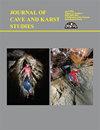新墨西哥州泰勒山地区霍勒斯台地西南部具有重要考古意义的砾石和滞后沉积物的起源
IF 0.5
4区 地球科学
Q4 GEOSCIENCES, MULTIDISCIPLINARY
引用次数: 1
摘要
先前和正在进行的考古调查已经确定了普韦布洛人和前普韦布洛人居民使用的黑曜岩结核的重要来源。黑曜岩结核发现于霍勒斯台地北缘西南顶部0-1.5米厚的薄砾石和滞后沉积物中,其线性距离约为2.5公里。含黑曜石矿床(OBD)从台地边缘向南和向东延伸300米,部分由193森林服务局穿越。OBD的东部与较厚的、不含黑曜石的火山碎屑沉积物混合,这些火山碎屑沉积物来自位于东部10至15公里的泰勒火山层状火山。OBD上覆斜辉石岩-斑玄武岩的年代为2.64±0.01 Ma。除黑曜岩外,OBD中还含有相对较浅的脱氮流纹岩、稀有的燧石和稀有的前寒武纪结晶碎片。OBD岩石大多呈亚角到角状,分选效果差。结节大小一般在1至10厘米之间;有几个更大。结核的外表面有中度氧化,有些有轻微的蚀刻。以前的研究表明,GR黑曜岩(≥3.28 Ma)的化学性质不同,年龄更大(≤3.03 Ma)。我们对OBD中清洁和破碎的黑曜岩结核进行了综合化学分析,并将结果与来自两个不同位置的清洁和破碎的黑曜岩岩屑碎片的分析结果进行了比较。分别)。GR火山岩流纹岩和黑曜岩具有较高的F和Cl浓度。我们还比较了OBD中结核的40 Ar/ 39 Ar年龄与GR上部菱灰岩位置的黑曜岩岩石年龄。OBD中三个均质结核的年龄为3.462±0.008 Ma,而几年前测定的GR黑曜岩岩石的年龄为3.28±0.04 Ma。GR流纹岩中心北北侧的黑曜石样品的年龄为3.498±0.003 Ma(所有年龄在必要时使用FC-2氰化钾监测年龄重新计算)。然而,后一种黑曜石的质地与其他黑曜石不同。3个测年结果表明,OBD和GR矿床中的黑曜岩起源于≤200 kyr的GR流纹岩火山作用。现今的Lobo峡谷位于GR流纹岩中心附近,深2225米,与Horace Mesa(2440米)的OBD矿床横向分隔约4至5公里。由于OBD沉积物覆盖在Horace Mesa Lobo峡谷两侧的年轻玄武岩上,我们推测在过去2.64 Myr Lobo峡谷雕刻出≥215 m的火山岩和沉积岩。本文章由计算机程序翻译,如有差异,请以英文原文为准。
Origin of Archaeologically Significant Gravel and Lag Deposits on Southwestern Horace Mesa, Mount Taylor Region, New Mexico
Previous and on-going archaeological investigations in and around Lobo Canyon in the Mount Taylor volcano region have identified an important source of obsidian nodules used by Puebloan and Pre-Puebloan inhabitants. The obsidian nodules are found in thin gravel and lag deposits 0-1.5 m thick on the top of the southwesterly part of the northern edge of Horace Mesa over a linear distance of roughly 2.5 km. The obsidian-bearing deposits (OBD) extend as much as 300 m south and east from the mesa edge and are partially traversed by Forest Service 193. The east portion of the OBD grades into and mixes with thicker, non-obsidian bearing volcaniclastic deposits that are shed from the Mount Taylor stratovolcano located 10 to 15 km to the east. The OBD overlie clinopyroxene-phyric basalt dated at 2.64 ±0.01 Ma on the west. In addition to obsidian, the OBD contain relatively aphyric devitrified rhyolite, rare chert and rare Precambrian crystalline fragments. Most of the OBD rocks are subangular to angular, and are poorly sorted. Nodule sizes generally vary from 1 to 10 cm; a few are larger. Outer surfaces of the nodules are moderately oxidized and some are slightly etched. and obsidian lithic fragments in the upper of Ridge (GR) Previous work shows that GR obsidians (≥3.28 Ma) are chemically distinct and older (≤3.03 We obtained a composite chemical analysis of cleaned and crushed obsidian nodules from the OBD and compared results with analyses of cleaned and crushed obsidian lithic fragments from two different locations in the The three analyses are virtually identical in major and trace elements, and in contents of F and Cl (about 4700 and 720 ppm, respectively). Relatively high F and Cl concentrations are characteristic of rhyolite and obsidian from GR volcanics. We also compared the 40 Ar/ 39 Ar age of nodules in OBD to obsidian lithics in one of the upper GR ignimbrite locations. Three homogenized nodules from the OBD produced an age of 3.462 ±0.008 Ma whereas the GR obsidian lithics dated several years ago returned an age of 3.28 ±0.04 Ma. A sample of obsidian from the NE flank of GR rhyolite center yielded an age of 3.498 ±0.003 Ma (all ages recalculated using the FC-2 sanidine monitor age where necessary). However, the latter obsidian is different in texture than the others. The three dates suggest that the obsidians within OBD and GR deposits originated from GR rhyolitic volcanism over a span of ≤200 kyr. Present-day Lobo Canyon is 2225 m deep near GR rhyolite center, and is laterally separated from the OBD deposits on Horace Mesa (2440 m) by about 4 to 5 km. Because the OBD deposits overlie a young basalt flanking Lobo Canyon at Horace Mesa, we speculate that ≥215 m of volcanic and sedimentary rock was carved out of Lobo Canyon in the last 2.64 Myr.
求助全文
通过发布文献求助,成功后即可免费获取论文全文。
去求助
来源期刊

Journal of Cave and Karst Studies
地学-地球科学综合
CiteScore
1.90
自引率
0.00%
发文量
6
审稿时长
>12 weeks
期刊介绍:
The Journal of Cave and Karst Studies is a multidisciplinary journal devoted to cave and karst research. The Journal is seeking original, unpublished manuscripts concerning the scientific study of caves or other karst features. Authors do not need to be members of the National Speleological Society, but preference is given to manuscripts of importance to North American speleology.
 求助内容:
求助内容: 应助结果提醒方式:
应助结果提醒方式:


